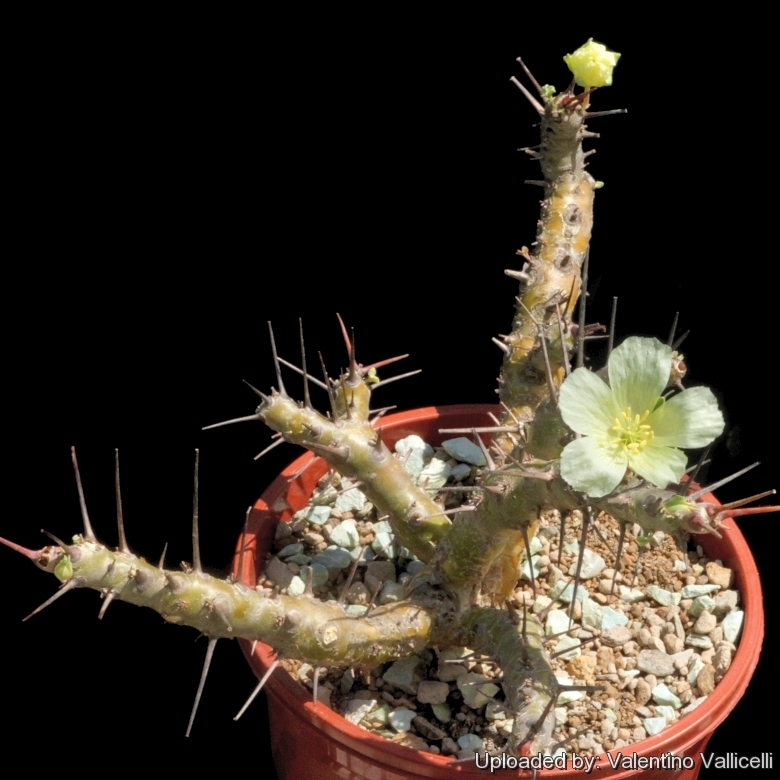
Monsonia flavescens Photo by: Valentino Vallicelli
Origin and Habitat: It is narrow endemic from near the mouth of the Orange River in Namibia and in Northern Cape Province, South Africa.
Altitude: Up to 1100 m
Hbitat and ecology: They grow individually, openly in dry sandy or rocky grounds along with scarce scattered xerophytic vegetation. They lack leaves for most part of the year and produce leaves only after important fogs or sufficient rains.
Synonyms:
Common Names include:
ENGLISH: Bushman's Candle, Candle Bush, Groot Kersbos, Boesmankers
Description: It is a perennial relatively large semi-erect or erect succulent shrub 10-40(-70) cm tall. This is a winter-grower species.
Stem: Short with few spines, branching just above soil level. Branches less than 10 cm wide, grey to greys-yellow covered with waxy, translucent bark.
Roots: Not swollen.
Leaves: Entire, but variably-shaped, ovate to orbicular, margins lobed and variably-incised less than halfway to midrib 7-18 mm long, 6-13 mm wide. Dimorphic (two forms) leaves characterize the genus, with the blades either long or shortly petioled. The long petioles occur singly and remain as blunt or sharp spines, the short ones occur singly or in groups of 2-7 in the axils of the long spines as blunt stalks.
Spines: Grey-brown.
Flowers: from 1-3 blunt stalks in axils of spines, withe or in different shades of yellow 3 cm in diameter; 5-merous with the sepals of the calyx and the petals free, petals 14-17 mm long (rarely up to 2 cm long). It has 15 stamens, 5 with long filaments and 10 with shorter filament. Sepals glabrous.
Notes: The fleshy branches, covered with wax, are flammable and can even when wet be used as a kindling to light fires.
Bibliography: Major references and further lectures
1) Albers F. “Monsonia” in:Urs Eggli “Illustrated Handbook of Succulent Plants: Dicotyledons” Springer Science & Business Media, 2002
2) Jean-André Audissou “The genus Sarcocaulon (De Candolle) Sweet (1826)” CACTUS-AVENTURES International N° 70
3) Moffett R. O. “The genus Sarcocaulon” in Bothalia Vol. 12, N°. 4 (1979) : 581-612.
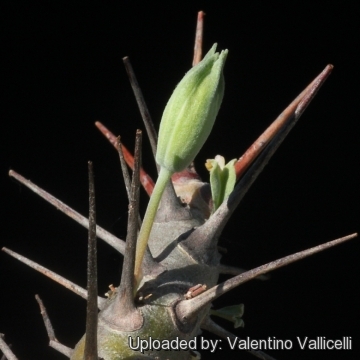 Monsonia flavescens Photo by: Valentino Vallicelli
Monsonia flavescens Photo by: Valentino Vallicelli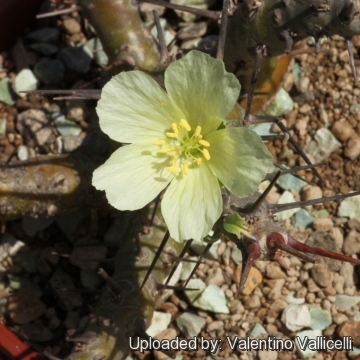 Monsonia flavescens Photo by: Valentino Vallicelli
Monsonia flavescens Photo by: Valentino Vallicelli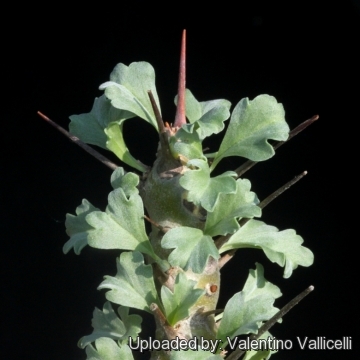 Monsonia flavescens Photo by: Valentino Vallicelli
Monsonia flavescens Photo by: Valentino Vallicelli Monsonia flavescens Photo by: Valentino Vallicelli
Monsonia flavescens Photo by: Valentino Vallicelli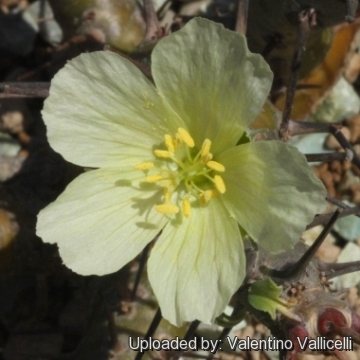 Monsonia flavescens Photo by: Valentino Vallicelli
Monsonia flavescens Photo by: Valentino VallicelliSend a photo of this plant.The gallery now contains thousands of pictures, however it is possible to do even more. We are, of course, seeking photos of species not yet shown in the gallery but not only that, we are also looking for better pictures than those already present.
Read More... Cultivation and Propagation: Sarcocaulon flavescensSN|22929]]SN|22929]] is a decorative plant which has the fame to be difficult to care properly in cultivation, however it is relatively easily grown species, very suitable for bonsai. Seed-grown plants thrive and flower prolifically in cultivation while imported specimens rarely produce an extensive new root system and flower sporadically, but survive for many years.
Exposure: They require direct sunlight when in full growth, while a filtered exposition is best during the hottest period of summer, when the plants enter in their dormancy phase. They always grow best in positions where they receive long periods of strong sunlight
Watering: They need to be regularly watered every 6 to 10 days whilst they are in active growth and and producing leaves, occasionally during dormancy. In cultivation it appear best not to let plants go into dormancy and to water year round. Nevertheless even in habitat the Sarcocaulons appear to be opportunistic and respond to precipitation events when they occur. As soon as the foliage starts to show signs of yellowing or withering, water should be withheld. It is very important that there is plenty of free air circulation around cultivated plants and also that they are not overwatered.
Soil: The ideal cultivation medium is very draining with at least 75% of pumice and lava grit.
Propagation: All Sarcocaulon species are readily grown from seeds. Seeds should be sown just under the surface of the soil, in large seed trays or plastic pots. They should be planted out into individual containers when they are about two years old. The most dangerous period for seedling is in summer. They need to be kept dry whilst dormant but at the same time their trunk do not withstand continual drought. The seedlings adapt to the climate where they are grown and develop a vigorous root system.















